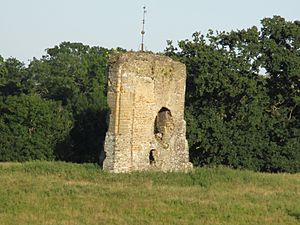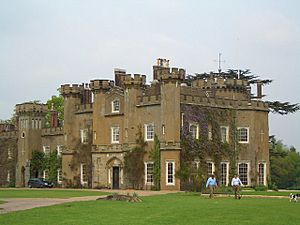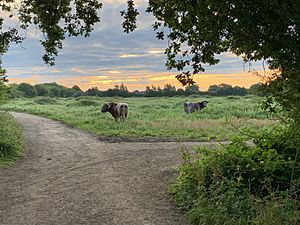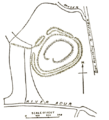Knepp Castle facts for kids
Knepp Castle is an old castle ruin located in West Sussex, England. It stands west of the village of West Grinstead, close to the River Adur and the A24 road. The name "Knepp" probably comes from an old English word, "cnæp," which means "mound." This makes sense because the castle was built on a raised piece of land. Today, the area around the castle is well-known for a special nature project called Knepp Wildland.
Contents
History of Knepp Castle
Building the First Castle
Knepp Castle began as a type of fortress called a motte and bailey castle. This means it had a large mound (the motte) with a wooden tower on top, and a walled courtyard (the bailey) below. It was built in the 12th century by a powerful lord named William de Braose.
A Stone Castle and Royal Visitors
Later, in 1214, King John rebuilt the castle using stone. He added a strong, two-storey tower, known as a keep. Many important people visited Knepp Castle over the years. These included King John himself, King Henry III in 1218, King Edward II in 1324, and King Richard II in 1384.
The Castle's Decline and Preservation
After these royal visits, the castle slowly fell into disrepair. By the 1720s, most of it was already destroyed. In the early 1800s, Sir Charles Burrell took steps to protect the remaining parts. He reinforced the ruins and put a fence around them to stop further damage.
What Remains of the Castle
The castle stands on an oval-shaped mound, which was originally a natural hill. This mound was surrounded by a ditch and raised banks called ramparts. The ditch was filled with water from a nearby pond, creating a moat. This moat still held water in the early 1700s.
Today, only a single wall of the original castle remains. This wall is about 11 meters (36 feet) high, 9.5 meters (31 feet) long, and 2.5 meters (8 feet) thick. It has a doorway and another opening above it. This surviving wall was likely the north end of the west wall of a large tower or keep.
The Other Knepp Castle
It's important to know that the name "Knepp Castle" is also used for a different building nearby. This is a large, fancy house built in the early 1800s by Sir Charles Merrik Burrell. It was designed by a famous architect named John Nash. This house looks like a castle, with towers and battlements, and is built in the Gothic Revival style. It is currently the home of Sir Charles Burrell, 10th Baronet.
Knepp Wildland Project
The land surrounding the old castle is now home to Knepp Wildland. This is a very important project because it's the first large-scale rewilding effort in England. Rewilding means letting nature take its course and allowing the land to return to a wilder state. The project covers about 1,400 hectares (or 3,500 acres) of land. This land used to be used for farming, growing crops and raising dairy cows, and is owned by Charles Burrell.
Images for kids









